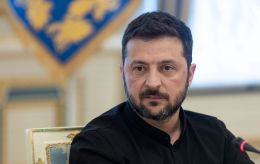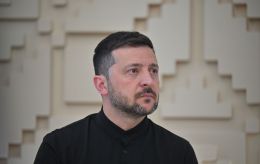Chief of Ground Forces on handed over conscription: 'Additionally to rights, everyone has duties'
 Volodymyr Fityo, the Public Relations Chief of the Ground Forces Command of the Armed Forces of Ukraine (Photo: Facebook)
Volodymyr Fityo, the Public Relations Chief of the Ground Forces Command of the Armed Forces of Ukraine (Photo: Facebook)
Volodymyr Fityo, the Public Relations Chief of the Ground Forces Command of the Armed Forces of Ukraine, in an interview with RBC-Ukraine, provided insights on mobilization conducted in Ukraine during the war, where and how the Territorial Defense Forces (TDF) can deliver conscription notices, and who will be mobilized to the front during the war.
About the ways of delivering conscription notices
At present, conscription notices – notification measures – can be delivered to conscripts by representatives of local authorities. This includes Territorial Recruitment and Social Support Centres (TRCs and SSCs), heads of enterprises of all forms of ownership, representatives of housing and communal services and homeowners' associations, village heads, elders, and representatives of territorial communities. According to Fityo, delivering notices is possible in public places, such as sports halls and restaurants.
"A sports hall is a public place. The law establishes that notification measures can be carried out where not prohibited. In this case, it is an institution that provides public services, just like catering establishments. And if their owners do not object, representatives of the TRCs can conduct notification measures for citizens who may fall under mobilization," explained the Public Relations Chief of the Ground Forces Command.
Fityoexplained that if a conscript sees the conscription notice in his mailbox or inserted in the door of his home, he can ignore it. After all, by law, the notice must be handed over personally. However, suppose the citizen is conscious and does not try to avoid mobilization. In that case, he should appear at his TRC and SSC to update his military registration data and undergo a medical examination.
Additionally, if a person is entitled to a deferral from mobilization, the conscript must personally inform his TRC and SSC about it. For example, if a bedridden mother needs care, this should all be documented, and these documents should be provided to the TRC and SSC in person.
About complaints about the actions of TRC representatives
The Ground Forces Command advocates for conducting all notification measures and mobilization events exclusively within the legal framework. If there are cases when force is used, or doors are broken during the delivery of conscription notices, citizens need to contact the police or call the Ministry of Defense hotline. Investigations are conducted, and legal assessments of the actions of TRC representatives are provided for all such cases, according to Fityo.
"But one should not forget that, additionally to rights, everyone also has duties. And every citizen must defend the Motherland, which is enshrined in the Constitution. And when they start sorting out such situations, it turns out that in most cases, citizens tried to avoid mobilization during such conflicts," said the chief of the public relations service of the Ground Forces Command.
In addition, all citizens moving around the city must have documents that certify at least their identity. And if there is a military registration document, questions to conscripts aged 18 to 60 years will be absent altogether.
According to Fityo, the number of resonant cases where TRC representatives use force is insignificant. However, due to becoming public and the work of Russian propaganda, a false impression is created that this happens all the time.
"Moreover, now in the TRC and SSC, the majority of servicemen are those who have returned from the front, who have been injured, who have concussions, who have been mobilized and fought on the front. And I think for them, it is extremely offensive to hear any negative words towards them. And Russian propaganda precisely disperses this – that they are 'rear rats,' that 'they should be sent to the front.' They have already been to the front. They have already returned from the front. And now they are helping to conduct notification measures," explained Fityo.
About launching an electronic registry of conscripts
Currently, the electronic registry of conscripts "Oberig" is operational. But at the moment, it is not synchronized with other state registries, explained in the Ground Forces. Additional legislation is required for this synchronization. When this registry is synchronized with others, in most cases, the need for notification measures in restaurants, sports halls, or checkpoints will simply disappear, says Fityo.
"And we will see, for example, that a citizen was registered in Kyiv, but now he works in Lviv because the tax on his salary – personal income tax (PIT) – is paid in the Lychakivskyi district of Lviv. Accordingly, there will be a simple appeal to the owner of his enterprise, any form of ownership, that this citizen needs to appear at the Lychakivskyi TRC of the city of Lviv. And the head of the enterprise will be obliged to deliver this conscript to the TRC and SSC personally," the Ground Forces note.
Currently, the electronic database operating in the TRC only allows notification measures to be conducted for citizens anywhere in the country. That is, a citizen from Luhansk or Sumy can receive a conscription notice in Odesa. This data, which was in paper form, is transferred to electronic form. This allows the personal file to be seen, for example, in another TRC of the region.
What happens after a person receives a conscription notice
A conscription notice is not a dispatch to the front. A conscription notice is for clarifying registration data and emphasizing Fityo. According to him, after a person appears at the TRC and SSC, they undergo a medical examination and provide all their documents. If there is a right to a deferral, that right is granted.
"If there is no right, and if the person's specialty is currently in demand, they receive a second notice, which is already a mobilization order, under which the conscript citizen appears at the specified place and date with the necessary list of documents and things. And then this person is already directed to the training center," explained the Public Relations Chief of the Ground Forces Command.
Next, in the training center, the recruit – mobilized citizen – undergoes training for at least one month. This is basic military training for the position of a shooter. Then, for two weeks, coordination takes place, and only after that is the allocation to his military unit. If the profession is more complex, it requires more time for training. It may take two or three months. Therefore, the mobilized person's path is extensive, and they are not immediately sent to the front.
Those who want to join the military on a contract basis can choose where to serve. For example, if you are interested in a particular brigade and want to be an artilleryman there, you simply contact that brigade, get a referral for that position, then contact your territorial recruitment center and say, "I want to defend Ukraine on a contract and want to serve in that brigade." However, those who enter the military through mobilization have no choice.
Whether eighteen-year-old men are mobilized and what happens with the mobilization of women
According to Fityo, Ukraine currently has active military conscription. This category includes draftees aged 18 to 27. Now, men in this age group are not conscripted through mobilization. Those subject to mobilization at the moment are men aged 27 and older.
As for women, female medics have always been liable for military service, as explained in the Ground Forces. After completing their university studies, even before the war, they were supposed to be enlisted in the military at their TRC and SSC. However, Russian propaganda has tried to exaggerate and distort this issue.
"Now our female medics just call their TRC and SSC, agree on when they can come, undergo a medical examination, provide the necessary documents, register for military service, and continue their work. There was no fuss, we do not mobilize women into the army. As practice shows, Russian propaganda has completely lost in this matter," explained Fityo.

